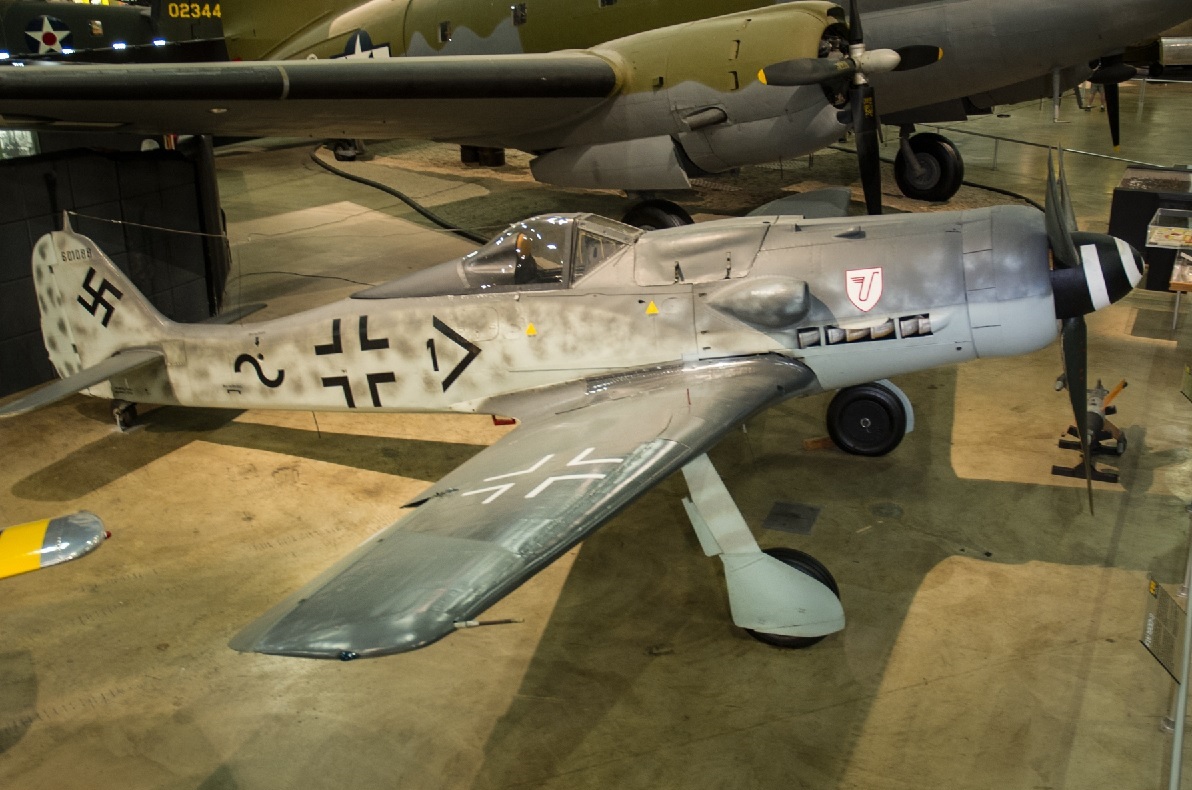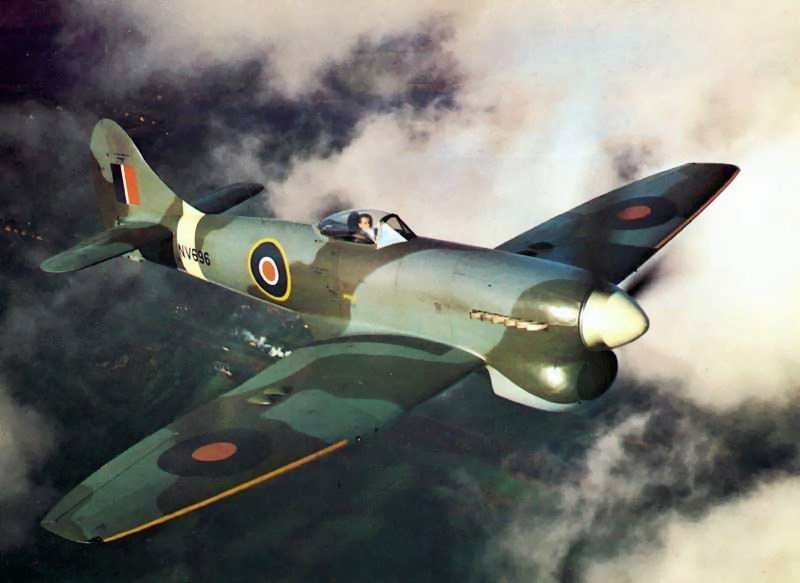Flg Off Paul Breger, who had bailed out of his Fw 190D-9 in response to the attack by the Green Section, was struck by Bevan Hall’s spiraling Tempest as he descended. The fighter exploded as it struck the ground on the road between Handorf and Dorbaum. Breger crashed to the ground burning up his parachute, while Hall was later discovered dead
The Tempest V and Fw 190D-9, arguably two of the best fighters ever built, set new standards for operational efficiency and aircraft design during World War II. At this late point of the war and in their positions, they did in fact represent the cutting edge and apex of their respective countries’ piston-engined aircraft development. In late summer 1944, the long-nosed Fw 190D-9 made its maiden appearance on the frontline. Thanks to its powerful Jumo 213 engine, it swiftly outperformed the majority of the fighters the RAF, USAAF, and Soviet Red Air Force could field and was an immediate match for even the Griffon-engined Spitfire XIV and the P-51D/K.
Early in 1944, the Tempest V was sent into service, outfitting eight squadrons. When the fighter was sent out to intercept V1 flying bombs over southern England, it quickly established itself as a reliable performer. As the Allied armies advanced throughout northwest Europe beginning in the fall of 1944, the Tempest V also outfitted squadrons of the 2nd Tactical Air Force.
The first dramatic test between the Tempest and the “Dora” occurred on December 27, 1944, in clear skies, when eight aircraft from No. 486 Sqn on an armed reconnaissance to the Paderborn area encountered the 60 or so D-9s from III./JG 54 on a significant airfield protection flight for Ar 234s, according to Robert Forsyth’s book Tempest V vs Fw 190D-9. The D-9s were in a staggered formation at a height of between 6,500 and 10,000 feet, led by the Stabsschwarm, while the Tempests were flying in two “finger-four” sections of four aircraft.
To the right and left of the Stab were, 9., 11. and 12. Staffeln, while flying top cover was 10. Staffel led by Leutnant Peter Crump, a 24-victory ace — all of his kills had been claimed in the West while flying with II./JG 26 and included Spitfires, Mustangs, P-47s, and a Mosquito.
The two units met over the Munster area. The massive German formation was instructed to change direction from the southwest to the northeast after ground control reported the location of the Tempests. Hauptmann Robert “Bazzi” Weiss, a Knight’s Cross holder whose personal victory tally stood at 122 at the time, was the Gruppenkommandeur. As a result, the lower Staffeln was segregated from Crump’s Staffel. The pilots’ predicament was rendered even worse when, as Crump ordered them to reverse, they lost communication, scattered, and fell behind the rest of the Gruppe, leaving them extremely exposed to attack.

Sqn Ldr Keith Taylor-Cannon, also known as “Hyphen” to his teammates, was in charge of the Tempest squad. He was from Oamaru, New Zealand, and had participated in the downing of a Me 262 and a Ju 188. ‘We were flying at 10,000ft and sighted the Huns in two gaggles at “12 o’clock” to us,’ he later reported, ‘one formation of 15 109s andn190s at 9,000ft, with the top cover of 20+ 109s and 190s and at approximately 14,000ft.’
As Green Section ascended to engage 10./JG 54, Taylor-Cannon led Red Section into the German aircraft. The lower-flying Staffel of D- 9s was then passed by the Tempests as they drew up in line behind and slightly below it. ‘After breaking, I got on the tail of an Fw 190 and opened fire at 200 yards range,’ recounted Taylor-Cannon. ‘I observed strikes, and as I pulled up sharply to avoid it, I saw the Fw 190 blow up in mid-air. A general dogfight ensued.’
Pit Offs Sid J. Short and Keith A. Smith, both V1 aces, both claimed to have shot down a Fw 190. According to the reporting:
‘I got into line astern, slightly above an Fw 190, and opened fire with a short burst from about 400 yards using half-a-ring of deflection. I closed the range, and when within 200 yards fired a short burst and another at a very close range of 20 yards using a full ring of deflection. The Fw 190 blew up — I could not avoid the explosion but broke to starboard as I flew through it.’

Short noted in his Combat Report:
‘I selected an Fw 190 and commenced firing from about 200 yards range in line astern, allowing five degrees of deflection. I held my fire for about two seconds and saw large puffs of grey-colored smoke coming from beneath the fuselage. By this time I had a Me 109 [sic] on my tail firing at me so was forced to break to port and spun off. I did not see what happened to the Fw 190, but Red 4 — Flg Off Smith — saw it catch fire and the pilot bail out. After spinning off I recovered the spin and regained my section.’
Meanwhile, Green Section had engaged Crump’s Staffel. Flt Lt E. W. Tanner described how he:
‘. . . closed in behind a straggler of the enemy formation and identified it as an Fw 190 with a long-range tank. I fired a short burst from 200 yards range, allowing slight deflection and about five degrees off line astern but observed no strikes. Green 4 [Flg Off Smith] passed me very closely and I saw him open fire at the same aircraft from about 50nyards range. I saw the Fw 190 blow up in mid-air. The Hun formation had broken so I climbed up through it and saw a long-nosed 190 flying across my nose at about 60 degrees and about 200 yards range. I opened fire, allowing 2 1/2 rings of deflection, and saw strikes on the tail unit, large pieces of which fell off. I saw the 190 roll over on its back and dive steeply to earth. Flg Offs Stafford and Danzey saw it going down vertically without its tail unit and pieces coming away from the fuselage. I milled around with the Section and then pulled up above the main gaggle. I spotted a 109 [sic] on the tail of a Tempest, so I dived on the 109 and opened fire at about 400 yards, holding the burst until 150 yards. I saw strikes along the cockpit and saw the nose of then109 go down as if the stick had gone violently forward. I was being engaged by about four other enemy aircraft so could not follow the 109 down, but Green 4n[Flg Off Smith] saw it tumbling down end over end.’

The Tempest pilots completed their task quickly and effectively, shooting down three Fw 190D-9s flown by Feldwebel Karl Dahn, Feldwebel Arnfried Kohler, and Oberleutnant Paul Breger, all of 10./JG 54. With second-degree burns on his face and shrapnel in his foot, Kohler parachuted to the ground. Breger experienced particular bad luck. In order to place himself onto the tail of a Tempest that was following another D-9 in his Schwarm, Peter Crump had to make a tight maneuver. V1 ace Flg Off Bevan Hall of the Green Section, who had stepped in to help Flg Off Jack Stafford, was piloting the RAF fighter. According to Stafford, ‘a 109 [sic] jumped on my tail and stayed there shooting, although without hitting me.’
Crump registered strikes on Flg Off Hall’s Tempest, forcing him to bail out of his stricken machine as it fell away in a vertical dive. Paul Breger, who had bailed out after the attack by the Green Section, was struck by the spiraling Tempest moments later as he was floating downward through his parachute. The fighter exploded as it crashed into the ground on the road between Handorf and Dorbaum. Breger crashed to the ground burning up his parachute, while Hall was eventually found dead.
Crump saw the D-9 of Unteroffizier Max Mittelstadt of 10 Staffel crash land with its Jumo 213 on fire as the dogfight raged and drifted over Munster-Handorfnairfield. Oil sprayed across Mittelstadt’s windscreen as he attempted to land his aircraft. Mittelstadt was a former flight instructor from JG 103. He attempted to gaze out while opening his canopy but was instead hit in the face with additional boiling oil. At the conclusion of his very first combat mission, Mittelstadt crash-landed and lost consciousness as he was being extricated from the wreckage of his now-wingless D-9 by another pilot.
Feldwebel Walfried Huth, a member of 12./JG 54, crashed and died at Telgte, and Unteroffizier Kurt Hein’s D-9 sustained damage. One German pilot wrote in his diary following the encounter, ‘I just escaped from a wild dogfight with my skin. Our formation disintegrated completely, no trace of an “air battle”, just wild confusion. Another mentioned in a letter home must praise my machine.’ No. 486 Sqn ended up shooting down five Fw 190D-9s and damaging another for the loss of Fig Off Bevan Hall and his Tempest. Because the soldiers of the battered 10./JG 54 were so traumatized by their ordeal, Bazzi’ Weiss made the decision to put them on leave for a few days.
Tempest V vs Fw 190D-9 is published by Osprey Publishing and is available to order here.
Photo by U.S. Air Force and Royal Air Force

